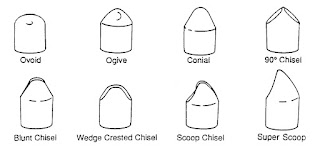Tungsten Carbide Cutting Structures
Since most of the basic design features of the mill tooth cuttings structures
have been incorporated into insert bits, the main variations occur in insert
shape (Figure 3-5).

Figure 3-5: Tungsten Carbide Tooth Shapes
Historical shapes of milled teeth have built up a mystique about insert tooth
shape. Many people in the oil field thought that chisel shaped teeth
significantly affected the drill rate in all formations. This was because early
drilling practices used light bit weights, causing the relatively sharp chisel
shaped inserts to have a higher unit loading on the formation, hence faster
drill rates. When heavier bit weights are used, it tends to nullify the
advantage of the chisel shape. Even the steel milled teeth break down under
heavy weights. In fact, most bits drill 75% of the hole in a 1/2 to 3/4 dull
condition. With this in mind, many “blunt” insert tooth designs were made,
and seem to drill efficiently. Nowadays, most insert teeth have this blunt,
conical shape.
Since most of the basic design features of the mill tooth cuttings structures
have been incorporated into insert bits, the main variations occur in insert
shape (Figure 3-5).

Figure 3-5: Tungsten Carbide Tooth Shapes
Historical shapes of milled teeth have built up a mystique about insert tooth
shape. Many people in the oil field thought that chisel shaped teeth
significantly affected the drill rate in all formations. This was because early
drilling practices used light bit weights, causing the relatively sharp chisel
shaped inserts to have a higher unit loading on the formation, hence faster
drill rates. When heavier bit weights are used, it tends to nullify the
advantage of the chisel shape. Even the steel milled teeth break down under
heavy weights. In fact, most bits drill 75% of the hole in a 1/2 to 3/4 dull
condition. With this in mind, many “blunt” insert tooth designs were made,
and seem to drill efficiently. Nowadays, most insert teeth have this blunt,
conical shape.
Hi This one is really a good post. It is going to help me a lot. The stuff and is very well topic related and useful for me. I quiet like the writers point of view. Good job.
ReplyDeleteSilicon edge polishing